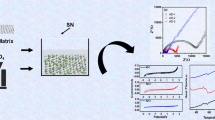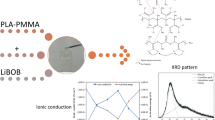Abstract
A study is carried out on solid polymer electrolytes (SPEs) based on UV-curable glycidyl methacrylate (GMA) reactive mixtures to determine the lithium bis(trifluoromethylsulfonyl)imide (LiTFSI) effect at different weight percentages. These polymeric systems are discussed considering several factors such as chemical interaction, structural and thermal properties, ionic conductivity, and lithium transference number. Samples are prepared using solution casting technique and are analyzed using Fourier transform infrared spectroscopy (FTIR), X-ray diffraction (XRD), differential scanning calorimetry (DSC), and electrochemical impedance spectroscopy (EIS) characterization methodologies. FTIR spectra show that interaction occurs between electronegative atoms in polymer host and TFSI− ions. XRD diffractogram indicates the amorphous aspect of SPEs, without the presence of LiTFSI peaks. Doping with LiTFSI salt reduces the glass transition temperature of SPEs and increased their ionic conductivity. Identified as the ideal salt concentration for poly(glycidyl methacrylate) (PGMA)-LiTFSI SPE system is 30 wt.% LiTFSI doping level, thus achieving a ionic conductivity of 3.69 × 10−8 S cm−1 at ambient temperature and 1.23 × 10−4 S cm−1 at 373 K. The ionic conductivity behavior obeys the Vogel–Tamman–Fulcher equation with an activation energy of 0.054 eV.








Similar content being viewed by others
References
Bella F, Mobarak NN, Jumaah FN, Ahmad A (2015) From seaweeds to biopolymeric electrolytes for third generation solar cells: an intriguing approach. Electrochim Acta 151:306–311
Kurc B, Jesionowski T (2015) Modified TiO2-SiO2 ceramic filler for a composite gel polymer electrolytes working with LiMn2O4. J Solid State Electrochem 19(5):1427–1435
Jayathilake YMCD, Perera KS, Vidanapathirana KP (2015) Preparation and characterization of a polyacrylonitrile-based gel polymer electrolyte complexed with 1 methyl-3 propyl immidazolium iodide. J Solid State Electrochem. doi:10.1007/s10008-015-2834-7
Singh PK, Jadhav NA, Mishra SK, Singh UP, Bhattacharya B (2010) Application of ionic liquid doped solid polymer electrolyte. Ionics 16:645–648
Lewandowski A, Swiderska A (2004) New composite solid electrolytes based on a polymer and ionic liquids. Solid State Ion 169:21–24
Singh PK, Bhattacharya B, Mehra RM, Rhee HW (2011) Plasticizer doped ionic liquid incorporated solid polymer electrolytes for photovoltaic application. Curr Appl Phys 11:616–619
Gerbaldi C (2010) All-solid-state lithium-based polymer cells for high-temperature applications. Ionics 16(9):777–786
Stephan AM (2006) Review on gel polymer electrolytes for lithium batteries. Eur Polym J 42(1):21–42
Hodko D, Gamboa-Aldeco M, Murphy OJ (2009) Influence of photopolymerization conditions on the structure and property of poly (divinylbenzene) shells. J Mater Sci 13(7):1077–1089
Imperiyka M, Ahmad A, Hanifah SA, Rahman MYA (2013) Potential of UV-curable poly(glycidyl methacrylate-co-ethyl methacrylate) based solid polymer electrolyte for lithium ion battery application. Int J Electrochem Sci 8:10932–10945
Ahmad A, Rahman MYA, Su’ait MS, Hamzah H (2011) Studies of MG49-PMMA-LiBF4 based solid polymer electrolytes. Open Mater Sci J 5:170–177
Abbrent S, Lindgren J, Tegenfeldt J, Wendsjö Å (1998) Gel electrolytes prepared from oligo(ethylene glycol)dimethacrylate: glass transition, conductivity and Li+-coordination. Electrochim Acta 43:1185–1191
Hanifah SA, Hamzah N, Heng LY (2013) Rapid synthesis of magnetic microspheres poly(glycidyl methacrylate-co-styrene) by photopolymerization. Sains Malay 42(4):487–493
Su’ait MS, Ahmad A, Hamzah H, Noor SAM, Rahman MYA (2012) Preparation and characterization of blended solid polymer electrolyte MG49:PMMA–lithium tetrafluoroborate. J Solid State Electrochem 16(6):2275–2282
Sun B, Mindemark J, Edström K, Brandell D (2014) Polycarbonate-based solid polymer electrolytes for Li-ion batteries. Solid State Ion 262:738–742
Kotobuki M, Koishi M (2013) Preparation of Li1.5Al0.5Ti1.5(PO4)3 solid electrolyte via a sol–gel route using various Al sources. Ceram Int 39(4):4645–4649
Imperiyka M, Ahmad A, Hanifah SA, Mohamed NS, Rahman MYA (2013) Investigation of plasticized UV-curable glycidyl methacrylate based solid polymer electrolyte for photochemical cell (PEC) application. Int J Hydro Energ 39:3018–3024
Bella F, Imperiyka M, Ahmad A (2014) Photochemically produced quasi-linear copolymers for stable and efficient electrolytes in dye-sensitized solar cells. J Photochem Photobiol A 289:73–80
Imperiyka M, Ahmad A, Hanifah SA, Bella F (2014) A UV-prepared linear polymer electrolyte membrane for dye-sensitized solar cells. Physica B 450:151–154
Rodrigues LC, Barbosa PC, Silva MM, Smith MJ (2007) Electrochemical and thermal properties of polymer electrolytes based on poly(epichlorohydrin-co-ethylene oxide-co-ally glycidyl ether. Electrochim Acta 53:1427–1431
Singh TJ, Bhat SV (2003) Morphology and conductivity studies of a new solid polymer electrolyte: (PEG)xLiClO4. Bull Mater Sci 26:707–714
Mohd Noor SA, Gunzelmann D, Sun J, MacFarlane DR, Forsyth M (2014) Ion conduction and phase morphology in sulfonate copolymer ionomers based on ionic liquid-sodium cation mixtures. J Mater Chem A 2(2):365–374
Uma T, Mahalingam T, Stimming U (2005) Solid polymer electrolytes based on poly(vinylchloride)-lithium sulfate. Mater Chem Phys 90:239–244
Capiglia C, Imanishi N, Takeda Y, Henderson WA, Passerini S (2003) Poly(ethylene oxide) LiN(SO2CF2CF3)2 polymer electrolytes IV. Raman characterization. J Electrochem Soc 150(4):A525–A531
Borodin O, Smith GD, Henderson W (2006) Li+ Cation environment, transport, and mechanical properties of the LiTFSI doped N-methyl-N-alkylpyrrolidinium+TFSI− ionic liquids. J Phys Chem B 110:16879–16886
Ramesh S, Liew CW, Ramesh K (2011) Evaluation and investigation on the effect of ionic liquid onto PMMA-PVC gel polymer blend electrolytes. J Non Cryst Solids 357:2132–2138
Ramesh S, Teh GB, Louh RF, Hou YK, Sin PY, Yi LJ (2011) Preparation and characterization of plasticized high molecular weight PVC-based polymer electrolytes. Sadhana 35:87–95
Rodrigues LC, Silva MM, Smith MJ (2012) Synthesis and characterization of amorphous poly(ethylene oxide)/poly(trimethylene carbonate) polymer blend electrolytes. Electrochim Acta 86:339–345
Singh PK, Kim KW, Rhee HW (2009) Development and characterization of ionic liquid doped solid polymer electrolyte membranes for better efficiency. Synth Met 159:1538–1541
Doeff MM, Edman L, Sloop SE, Kerr J, De Jonghe LC (2000) Transport properties of binary salt polymer electrolytes. J Power Sources 89:227–231
Shim J, Kim DG, Kim HJ, Lee JH, Lee JC (2015) Polymer composite electrolytes having core-shell silica fillers with anion-trapping boron moiety in the shell layer for all-solid-state lithium-ion batteries. ACS Appl Mater Interfaces 7:7690–7701
Young NP, Devaux D, Khurana R, Coates GW, Balsara NP (2014) Investigating polypropylene-poly(ethylene oxide)-polypropylene triblock copolymers as solid polymer electrolytes for lithium batteries. Solid State Ion 263:87–94
Han P, Zhu Y, Liu J (2015) An all-solid-state lithium ion battery electrolyte membrane fabricated by hot-pressing method. J Power Sources 284:459–465
Olsen II, Koksbang R (1996) A temperature study of the ionic conductivity of a hybrid polymer electrolyte. Electrochem Soc Proc 143:570–574
Albinsson I, Mellander BE, Stevens JR (1992) Ionic conductivity in poly(propylene glycol) complexed with lithium and sodium triflate. J Chem Phys 96:681–690
Ghosh A, Wang C, Kofinas P (2010) Block copolymer solid battery electrolyte with high Li-ion transference number. J Electrochem Soc 157(7):A846–A849
Hiller MM, Joost M, Gores HJ, Passerini S, Wiemhofer HD (2013) The influence of interface polarization on the determination of lithium transference numbers of salt in polyethylene oxide electrolytes. Electrochim Acta 114:21–29
Acknowledgments
Author would like to acknowledge CRIM and Universiti Kebangsaan Malaysia for the support and opportunity given. This research is supported by the grant code ERGS/1/2013/TK07//UKM/02/4 and GGPM-2013-038.
Author information
Authors and Affiliations
Corresponding author
Rights and permissions
About this article
Cite this article
Radzir, N.N.M., Hanifah, S.A., Ahmad, A. et al. Effect of lithium bis(trifluoromethylsulfonyl)imide salt-doped UV-cured glycidyl methacrylate. J Solid State Electrochem 19, 3079–3085 (2015). https://doi.org/10.1007/s10008-015-2910-z
Received:
Revised:
Accepted:
Published:
Issue Date:
DOI: https://doi.org/10.1007/s10008-015-2910-z




